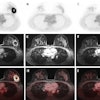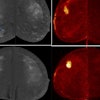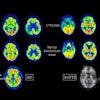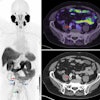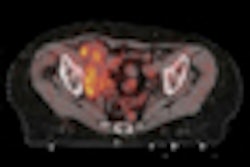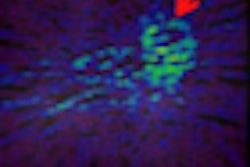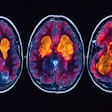
Could beams of ion species other than protons and carbon ions prove valuable for particle therapy? This question was posed in a scientific session at last month's annual meeting of the European Society for Radiotherapy and Oncology (ESTRO) meeting held in Barcelona.
The vast majority of today's particle treatments are performed using proton beams, with nearly 100,000 patients having received proton therapy to date. Carbon-ion beams are also utilized in centers in Japan and Germany, and have been used to treat more than 12,000 patients. But are there other ion species that could play a valuable therapeutic role?
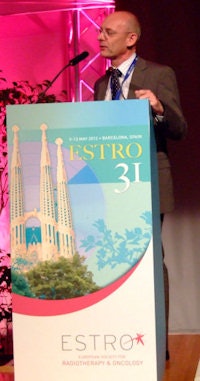 Oliver Jäkel, PhD, speaks at the ESTRO 31 meeting in Barcelona. Image courtesy of medicalphysicsweb.
Oliver Jäkel, PhD, speaks at the ESTRO 31 meeting in Barcelona. Image courtesy of medicalphysicsweb.
Oliver Jäkel, PhD, head of Medical Physics at Heidelberg Ion Beam Therapy Center (HIT) and the heavy ion therapy research group at the Deutsches Krebsforschungszentrum (DKFZ, the German Cancer Research Center) in Heidelberg, Germany, took a look at some of the alternatives. He explained that other types of ion beam have already been investigated for particle therapy. "Not many institutions are working on this, but it's a very interesting topic," he said.
Jäkel cited an early study at Lawrence Berkeley National Laboratory, in which 1,314 patients were treated between 1977 and 1992: 858 with helium ions and 456 with heavier ions such as carbon, neon, argon, and silicon. The results of this work indicated that, rather than the very heavy particles, the lightweight ions, and in particular carbon ions, appeared best suited for radiotherapy.
This study helped instigate the subsequent use of carbon ions for patient treatments; but according to Jäkel, carbon ions may not be optimal for all indications. He then described a more recent study that compared depth-dose distributions and linear energy transfer for particle beams ranging from protons up to oxygen ions. Helium ions and protons showed superior physical depth-dose distributions relative to the other beams studied.
It's also imperative to consider the lateral scattering of a particular ion beam, which will increase the beam diameter. Here, heavier beams have the advantage of exhibiting much smaller lateral scattering. Jäkel noted that even helium ions show greatly reduced lateral scattering compared to protons, providing a big benefit in terms of dose conformation. "Helium is interesting, as it has a nice conformal beam and can be easily produced in a cyclotron facility," he explained.
Dose-averaged linear energy transfer distributions suggested that the biological effectiveness in the target volume was higher for the heavier ions studied: carbon, nitrogen, and oxygen. However, with increasing mass, these beams also exhibited higher linear energy values outside the spread-out Bragg peak (SOBP) region, making beams of neon or argon unattractive for therapy. (This is a peak in the Bragg curve showing the average specific ionization of an ionizing particle of a particular kind as a function of its kinetic energy, velocity, or residual range.)
Jäkel explained that heavier particles, with atomic number of six or above, tend to exhibit projectile fragmentation, which produces positron emitters close to the Bragg peak that can be used for in-vivo PET monitoring.
To consider this effect further, Jäkel presented data showing the relative biological effectiveness of a series of ion beams used for fractionated irradiation of mouse cells. Carbon and neon ions exhibited increased relative biological effectiveness in the proximal- and mid-SOPB regions, compared with protons and helium ions. Argon ions exhibited even greater relative biological effectiveness values in these regions, but at the expense of extremely high relative biological effectiveness in the entrance region. He concluded that the optimal ion species may lie "somewhere between lithium and oxygen."
Radioactive irradiation
Jäkel also told the ESTRO delegates about a more extreme proposition: the use of radioactive ion beams for radiotherapy. One approach involves using a positron emitting beam, such as C-10 (which has a half-life of approximately 20 seconds) for PET-based range verification prior to treatment with C-12 ions. Another possibility is to use a radioactive beam, such as C-11 (which has a 20 minute half-life) for the actual treatment. This latter method would enable real-time, in vivo monitoring of the beam range.
"So why aren't radioactive beams used all the time?" Jäkel asked. The problem is that current facilities can only produce low intensities of such beams, which would necessitate long treatment times. While this approach has not yet been used in patients, studies are reasonably advanced. "We now need to drastically increase the production rate to enable reasonable treatment times," he explained.
Another approach involves the use of alpha-emitters, such as C-9 ions, which decay to B-9 and lead to alpha and proton emission in the Bragg peak region, thereby depositing additional dose into the target. Jäkel suggested that the advantage of C-9 appears is small at a realistic dose rate. "This seems like an exotic application that I don't think will reach clinical application," he said.
Jäkel rounded off his presentation with a look at developments currently underway at the Heidelberg Ion Beam Therapy Center. The center is now exploring the use of scanned O-16 beams, which can be produced using its existing carbon-ion source. This opens up the possibility of using a mixture of ions to perform linear energy transfer-optimized treatments. The center also plans to install a helium ion source later this year, providing the research facility with access to a wide-range of ions for preclinical studies and, ultimately, clinical applications.
© IOP Publishing Limited. Republished with permission from medicalphysicsweb, a community website covering fundamental research and emerging technologies in medical imaging and radiation therapy.

